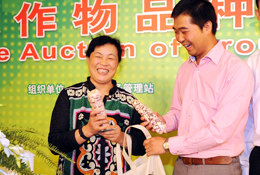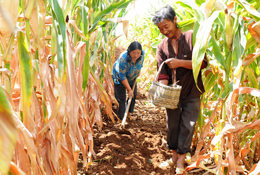|
 |
 |
|
SEED OF HOPE: A bidder wins four ears of a new corn variety at an auction of crop seeds in Beijing on September 21, 2011 (ZHANG XU) |
FIGHTING DISASTER: A farmer couple in Zhaotong, Yunnan Province, sow seed potatoes in a dourght-affected corn field on August 24, 2011, in hopes of making up their loss (CHEN HAINING) |
"Therefore China cannot depend on the international markets to fill domestic production gaps and the country must adhere to the policy of self-sufficiency and strive to supply more than 95 percent of its own consumption of rice, wheat and corn," Han said. He added that China's grain self-sufficiency will contribute to global grain security.
Though Han believes that China's grain output can be increased to meet increasing demand in the country, expanding the area under cultivation is obviously not an option as the country already has little spare land. But he expected progress in science and technology would be able to increase the average grain yield per-unit area in China by more than 1 percent each year by 2020.
"China's grain yields per-unit area is still far behind those of developed countries. In China, the yield per-unit area of the same crop differs widely in different areas, sometimes, by more than 750 kg per hectare in some cases," Han said.
In addition to increasing yields per-unit area, medium- and low-yielding farmland can also be improved to increase output.
"Currently, medium- and low-yielding fields account for 70 percent of the total, and their yields per-unit area can be improved by water conservancy construction," Han said.
At the annual central economic work conference that concluded on December 14, top economic policymakers discussed issues relating to agriculture, rural areas and farmers. Participants stressed the need to speed up progress in agricultural science and technology, boost relevant research and education programs and accelerate the application of new farming techniques.
Several industry insiders interviewed by Beijing Review at the end of last year expected agricultural science and technology would be the focus of the No.1 Document of 2012.
The No.1 Document is the first document released by the CPC Central Committee every year, which usually lists key and pressing problems to be solved by the ruling Party and the government during the year and serves as a guideline for the whole year's work.
Recently the document has become a synonym for the importance that the CPC Central Committee attaches to rural issues, because from 1982 to 1984 and from 2004 to 2010 the No.1 document focused on issues related to agriculture, the countryside and farmers.
In 2010, science and technology contributed 52 percent of China's agricultural growth, exceeding the contribution rate from land, the labor force and other production factors.
"In the next five years, China plans to increase the contribution rate of science and technology to more than 58 percent," said Pan Haiping, Deputy Director of the Science and Technology Education Department of the Ministry of Agriculture.
To achieve this goal, Pan said that the government will deepen reform of agricultural research institutes, improve agricultural science and technology management systems, spur innovation, promote the application of new farming techniques at the grassroots level, cultivate more able researchers, and give continuous and stable support to long-term research.
According to him, the development of China's agricultural science and technology has been hampered by insufficient investment and the lack of qualified people working in agricultural research.
Though government funding in agricultural science and technology has increased in recent years, fiscal investment in agricultural science and technology only accounted for about 0.25 percent of China's agricultural GDP, lower than the international average of 1 percent.
| 